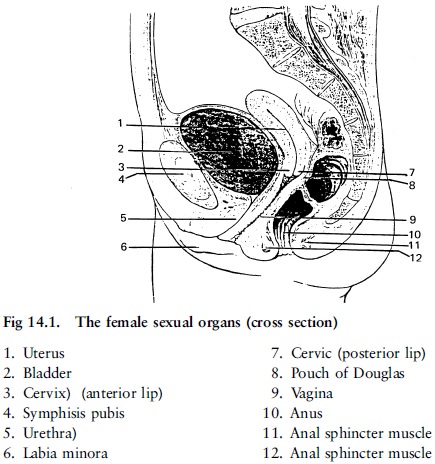Chapter: Forensic Medicine: Sexual offences
Interpretation of clinical findings
Interpretation of clinical findings
Extragenital injuries
The absence of signs of injury on
the complainant’s person should not be construed as consent to sexual
relations. She may have been overcome by fear, submitted under threat of harm
to her children or partner, or had been heavily intoxicated. In gang rapes,
where the victim is overcome by a number of assailants, or if attacked from the
back by a single person, it may be very difficult to offer any resistance.
Furthermore the victim may be examined shortly after the event, in which case
bruising, which may only appear many hours later, is not evident. It is therefore
sometimes indicated that the person must be re-examined 24 hours later.
Conversely, although the presence of injuries suggests that force was used to
overcome resistance — and the more exensive they are the more likely this is to
be the case — it should be borne in mind that the injuries may be unrelated to
the rape as such, the allegation of rape being part of a trumped-up charge. The
occasional bruise, nail scratch or bite mark is not infrequently inflicted
during over-zealous intercourse with consent. This includes a so called
love-bite.
It is also important to examine the
finger nails for any foreign material.
Genital injuries (fig 14.1 and 14.2)
In the case of a marked
disproportion in size between the assailant and the victim (eg when a child was
assaulted) the injuries to the genital organs may be extensive and extend into
the abdominal cavity and rectum. If the victim had borne children, no injuries
may be detected in or about the vagina, despite the fact that force was used to
penetrate the vagina. The presence of an intact hymen, depending on the type of
hymen, is not necessarily an indication of virginity. Neither is it an
indication that rape has not taken place. On occasion, rape is associated with
other aberrant sexually perverse acts such as sodomy, fellatio lingua (oral
stimulation of the sexual organ) and genital mutilation.


Laboratory test results
The results concerning injuries
related to sexual assault should be evaluated just as critically as test
results from any other type of injury. What the analyst conveys to the reader
should be what is read into the report, purely and simply, namely that from the
specimen a certain result was elicited. In evaluating this finding relative to
the subject under review the reader must determine whether the following was
carried out:
·
The specimen submitted for analysis was drawn properly.
·
It was adequately preserved in transit.
·
It was suitably identified.
·
It was not contaminated before or after collection.
·
It was representative of the subject matter under
consideration.
In addition, the method of testing
should be known to the reader, and its accuracy, specificity and the ability to
reproduce it, understood.
Molecular biology and the use of DNA
analysis has made it much easier toidentify an assailant. In the case of DNA
typing the result can prove beyond any doubt that a single hair, drop of blood,
sperm, minute fragment of tissue, et cetera, is derived from a particular
person. This specificity, which makes it possible to determine a person’s
identity almost 100% accurately, is due to the uniqueness of each individual’s
nucleic acid (DNA) structure of the cell, and hence the many different
permutations of each of these characteristics in any one individual.
General considerations
Ejaculation may have occurred in the
anus or on the perineal surface. Where no ejaculation has occurred, despite
penetration, there may be a considerable amount of secreted penile (urethral)
mucous which the woman may mistake for ejaculate. Intense emotion or
depressants such as alcohol or drugs may inhibit ejaculation.
The presence of smegma (secretion)
below a free pepuce (foreskin) suggests that the male has not had intercourse
for some days.
During sexual intercourse, where
there is marked disproportion in the sexual organs, the male may rupture the
frenular artery, which passes below the head of the penis, and it may bleed
profusely. In intercourse with consent this may be a source of considerable
embarrassment to both parties, and a revelation to a third party.
In studying the topic of rape it is
important to bear in mind that mere contact, for example when the penis is
placed on the vulva, constitutes penetration. Penetration, therefore, does not
necessarily involve penetration of the hymen.
There are a number of different anatomical
variations to the shape of the ‘‘virginal’’ hymen, ranging from an imperforate
to no more than a thin rim of tissue encircling the entrance to the vagina. The
following examples should elucidate this point:
·
Strips of hymenal tissue may still be present in women who
gave birth vaginally.
·
The hymen of the non-virginal non-parous (ie not giving
birth) woman, depending on the type of hymen, generally reveals an old rupture
at the mid-posterior position.
·
A ruptured hymen may be the result of masturbation, and the
hymen may bleed profusely.
·
Non-virginal women may have intact hymens, particularly of
the annular type. Cases have been reported of prostitutes where this type of
hymen revealed no evidence of having ever ruptured.
Spermatozoa may be found in the
vagina for as long as five to ten days after being introduced there. Although
motile spermatozoa can retain their motility for as long as five to ten days
after being introduced into the vagina, this period is reduced to no more than
an hour or two in the majority of cases.
The absence of spermatozoa in the
vagina does not mean that there was no ejaculation into the vagina. This
absence may be the result of azoospermia (absence of sperm) in the ejaculate,
or the use of a condom.
Related Topics